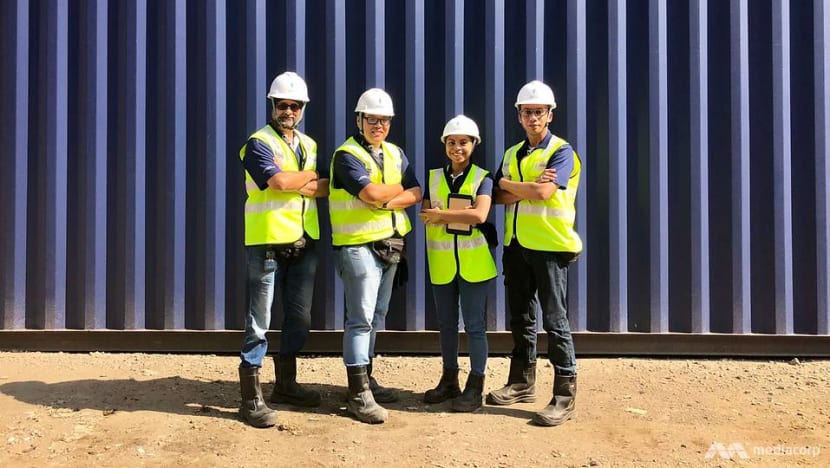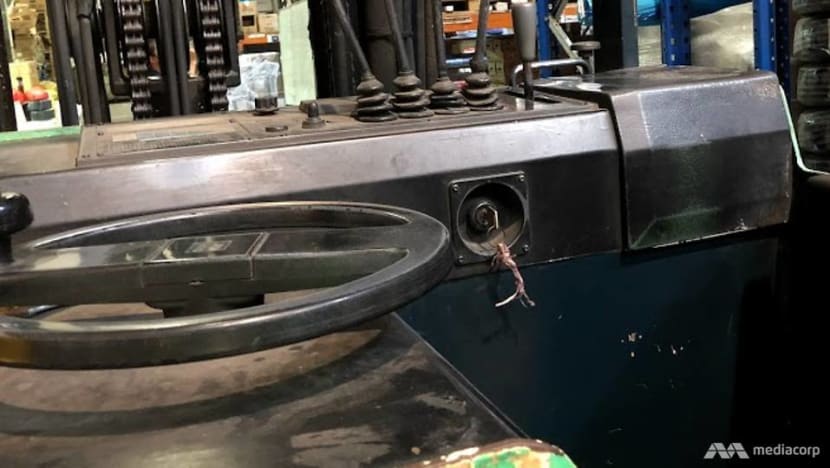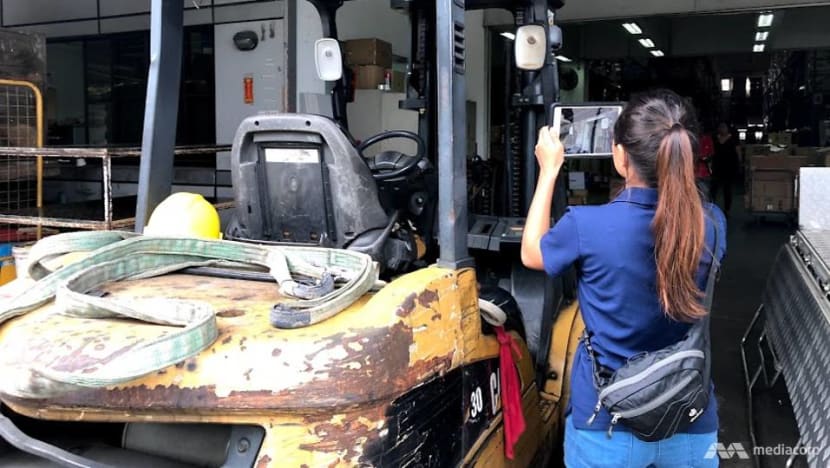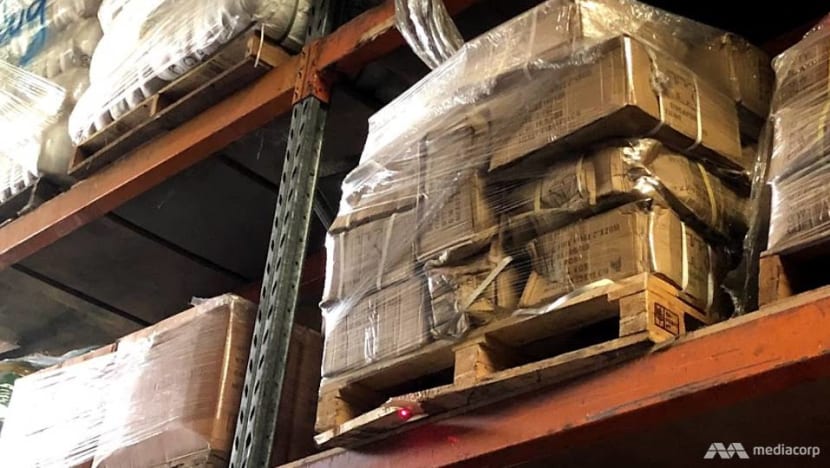Keeping employees safe and sound: On patrol with workplace safety inspectors
They visit workplaces to make sure they are safe for workers and meet with a variety of employers – from friendly to hostile ones. Channel NewsAsia's Fann Sim followed them for a day as they conducted surprise inspections.

Jaspal Singh, Anderson Ng, Siti Hajar Salim and Aidil Mohamed Riduan are among the 150 safety inspectors in Singapore conducting daily checks of workplaces to ensure a safe environment for workers. (Photo: Fann Sim)
SINGAPORE: In two cars, four safety inspectors pulled up outside a warehouse, about the size of three basketball courts, in Joo Koon Circle.
“Where is the front gate? Why are there no directional signs?” asked 24-year-old Siti Hajar Salim in a perplexed tone. She was taking the lead in the operation and was acting as navigator to her buddy-mentor Aidil Mohamed Riduan, 39.
The group is from the Ministry of Manpower’s Occupational Safety and Health Division, and they were inspecting a supply company. The division has already carried out more than 2,600 inspections this year.
The inspection, carried out earlier this month, was part of Operation Junco which targets workplaces where there are greater risks from accidents involving vehicles, such as warehouses, shipyards, construction worksites and delivery businesses.
The focus on such businesses comes against a backdrop of incidents involving vehicles being the leading cause of fatal injuries at work for the past three years. There were 14 such deaths in 2017 and they included being struck by moving vehicles, work-related traffic incidents on public roads and being caught in between vehicles.
READ: Jurong Shipyard fined S$230,000 over fatal accident
The supply company occupying the warehouse space was last visited in August 2016, and was due for a new inspection, said the MOM officers. Two years ago, the company flouted several safety regulations and was let off with a warning.

Findings from the previous inspection include leaving forklift keys in the ignition unattended, and obstructing the emergency exit door.
BEING FAST, FIRM AND BLUNT
Once inside the warehouse, Ms Hajar whipped out her iPad and started taking photos of everything she saw that could potentially contravene safety rules even before speaking to warehouse managers and workers.
Catching her attention was a battered forklift haphazardly operated by a worker between storage racks.
She then introduced herself to the warehouse manager Mr Lim, and conducted a briefing about the day’s inspection with him – such as asking for documents like the factory’s blueprint, products they carry and clarifying the number of workers and industrial vehicles.
“Mr Lim, just now I noticed one worker. Who is that? Can you call him over please,” Ms Hajar said. She explained to Channel NewsAsia that she saw the worker operating the forklift and so his operator's licence needed to be examined.
“Sometimes they see us, they just disappear. We ask for the worker and the worker disappears but I have photo evidence. That’s why I took the photo first,” said Ms Hajar.

Mr Lim accompanied the team to comb through the warehouse methodically, which took an hour. “We get the warehouse manager to guide us because they know the space best,” said Anderson Ng, 30, the team leader. Their initial impressions were “so far so good” and that Mr Lim had been cooperative.
In Singapore, workplaces such as shipyards and factories that handle petroleum products or high-cost engineering works, or those with more than 100 workers are required to appoint a safety officer.
Firms like the company that Mr Lim works for are not required to have one, and so employees may be unfamiliar with safety procedures and documents vital to at-risk workplaces.
“When they make us wait, it means that there’s not a good system,” Ms Hajar said. For example, logs like the daily safety checklist for vehicles should be placed in the vehicle itself, she explained.

During the inspection, the team found multiple issues – including using split wooden pallets to transport and store items, ladders used carelessly by workers, as well the very cluttered condition of the warehouse.
Ultimately, what crossed the threshold for the safety inspectors were the damaged racks still being used.

“Once you have damaged columns, the load is transferred from the beam to your columns to your foundation. It will reduce your safe working load. To how much? We don’t know. The assessor will only assess it when it is in working order but now it’s already damaged and twisted in some areas,” Mr Ng said.
The supply company was slapped with a partial stop-work order (SWO) which will be lifted only after the pallets and damaged racks have been replaced and evaluated again by a safety inspector.
MANAGING REACTIONS FROM HUMOUR TO HOSTILITY
After being served an SWO, a company representative immediately protested the decision made by Ms Hajar’s team.
“Huh! What do you mean? But we cannot not work. No sales how?,” he said tersely.
Mr Ng stepped in and said that they are not stopping the work of the company. It could continue with operations and sales but will have to stop any more work on the affected racks and pallets.
“What you can do now, you remove all the items on the damaged racks first because there is imminent danger that the racks may not be able to take the three tonnes. We are not stopping the operations like deliveries,” Mr Ng said, as he attempted to clear the air.
READ: Company fined S$290,000 over 'numerous, glaring oversights' resulting in death of worker
The man's frustrated response is common, the team said, but it is something they can work with. “It’s always a two-way conversation between the inspectors and the occupier. We have to understand from them what are their needs and special operations before we can make any assessment on whether there were any contraventions," said Mr Ng.
At another site - a shipping container yard along Penjuru Road - the officers met with a safety officer Rashad to carry out an inspection of the yard.
At this site there were several safety issues, such as not having a designated walking path for pedestrians and allowing drivers to walk under containers that were being moved.
Mr Rashad, the appointed safety officer from the occupier for the container yard, was knowledgeable about the inspectors' work and, at times, keen to make inject some humour into the process.
'You will see people like this trying to making a joke out of a serious situation but you have to be firm with what you are saying, what are the findings and what they have to rectify," said Ms Hajar.
"You can ignore all the jokes and laugh it off but the more important things need to be addressed first," she added.
Ms Hajar has seen her fair share of occupiers who react to her presence at their workplace in a disdainful manner. She found it challenging to get occupiers, who tend to be much older than her, to take her seriously.
"In the first few months ... I didn't have that level of confidence yet. Sometimes when you talk to occupiers, they might even undermine you," Ms Hajar said.
Some have even said that they have done things their way for a long time, and Ms Hajar is too young and lacks experience. She said she has learned to handle such occupiers by being firm and she will share stories of fatal injuries with such occupiers.
"To me, the worst safety violation is not telling your workers about the violations," she said.
"Going to the workplace is a proactive way of preventing accidents from happening. So when I go down and talk to the workers, it feels good. It's very fulfilling."














